Canadian Forces Naval Reserve
The Canadian Forces Naval Reserve (NAVRES, French: Réserve navale des Forces canadiennes) is the Primary Reserve component of the Royal Canadian Navy (RCN). The primary mission of the NAVRES is to force generate sailors and teams for Canadian Armed Forces (CAF) operations, including: domestic safety operations as well as security and defence missions, while at the same time supporting the Navy's efforts in connecting with Canadians through the maintenance of a broad national presence.[1]
| Canadian Forces Naval Reserve | |
|---|---|
| Réserve navale des Forces canadiennes (French) | |
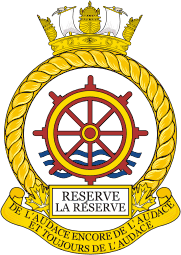 Badge of the Canadian Forces Naval Reserve | |
| Active | 1968–present |
| Country | Canada |
| Branch | Royal Canadian Navy |
| Role | Strategic reserve |
| Size | 5,100 Reserve personnel |
| Garrison/HQ | Quebec City, Quebec |
| Motto(s) | French: De l'audace, encore de l'audace, toujours de l'audace, lit. 'We must dare, and dare again, and go on daring' |
| Commanders | |
| Commander Naval Reserve | Cmdre Michael Hopper |
| Formation Chief Naval Reserve | CPO1 Michael Giguere |
History
Royal Naval Canadian Volunteer Reserve (1914–1918)
Canada's modern Naval Reserve finds its origins with the Royal Naval Canadian Volunteer Reserve (RNCVR) created on 14 May 1914 under the provisions of Naval Service Act. Organised into Atlantic, Lake and Pacific subcommands, 8,000 Canadians enlisted for service in the RNCVS during WWI. Agreeing to serve in wartime with either the RCN or the British Royal Navy (RN),[2] members of the RNCVR crewed 160 vessels, patrolling the shores of Canada and conducting convoy escort duties.[3] The RNCVR was extinguished four years later and its personnel demobilized following the end of the war in 1918.

Royal Canadian Navy Volunteer Reserve (1923–1945)
In 1923, the Royal Canadian Naval Volunteer Reserve (RCNVR) was stood up and under the command of Rear-Admiral Walter Hose who authorized the creation of NRDs in every major Canadian city. In 1941 Naval Reserve divisions were granted the designations ‘His or Her Majesty’s Canadian ships’ and received its own command and a seat on the Naval Board.[4] The new naval reserve establishment formed a robust reserve force building popular support amongst Canadians for the fledgling Canadian Navy. During the Second World War, the RCNVR became the backbone of the Canadian Navy, recruiting officers and sailors for the Navy. By the end of the war, Canada possessed the third-largest navy in the world, with a complement of nearly 100,000. Most of these men and women were members of the RCNVR.
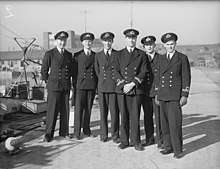
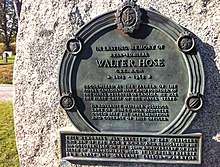
Naval Reserve (1945–1968)
With the end of the Second World War, the Naval Reserve was formed in 1945 replacing the RCNVR. Expected to maintain the same level of skill as the Regular Force, training and pay for reservists was equalised. Focused on minesweeping, escort, and coastal patrol; each division mirrored its organisation, training and crew with all officer branches and non-commissioned trades across the fleet.[5] Despite successfully expanding the University Naval Training Division (UNTD), forming a dedicated 'Commanding Officer, Naval Divisions' command in 1953 and attaching various tender craft to NRD's; the Naval Reserve experienced suffered a decline in skill due to focusing on generalist skills and lack of opportunities to sea-going ships leading up to the unification of the Canadian Forces in 1968.
Canadian Forces Naval Reserve (1968-1990)
With the unification of the Canadian Forces, the Naval Reserve was renamed the Canadian Forces Naval Reserve and years of decline set in. With no combat capability, except the Naval Reserve Naval Control of Shipping (NCS) program, the Naval Reserve lost political advocacy and was left out of any formal role in the Canadian Forces defence structure. Left outside the Canadian Forces structure, the Naval Reserve would rely on new and unique ways of keeping relevant during the Cold War years. With the UNTD program shuttered, for example, NRDs worked to expand their recruiting numbers by employing students at local level, and force generating sailors initially trained at the unit level to serve on major warships.[6] Years of decline was finally ended with Canada's 1987 White Paper on defence policy Challenge and Commitments.
Canadian Forces Naval Reserve (1990-2001)
With more integration of the Primary Reserve into the 'Total Force Concept' as outlined by the 1987 Defence White Paper, and then confirmed in the 1994 follow-up White Paper, the naval reserve was tasked with providing niche capabilities to assist the Regular Force. One such task undertaken by the naval reserve was to spearhead enhancing RCN mine countermeasures (MCM) operation capabilities and by crewing twelve new KINGSTON-class coastal defence vessels (MCDV), that since their introduction in 1996, have significantly contributed to Canadian maritime security and allied commitments, both domestically and internationally. The naval reserve was additionally tasked with maintaining standing Port Inspection Diver (PID) teams, supporting Regional Dive Centres and supplying four non-standing Port Security units and four Naval Control and Guidance to Shipping (the former NCS, now NCAGS) units.[6]
Mission
The mission of the NAVRES is to generate trained individuals and teams for CAF operations, including domestic safety operations as well as security and defence missions, while at the same time supporting the RCN's efforts in connecting with Canadians through the maintenance of a broad national presence.
The tasks of the NAVRES is to:
- Respond to domestic safety operations with trained sailors and small boat expertise.
- Provide specific unique skill sets for security missions for the RCN.
- Augment the fleet on any platform or shore capacity for defence missions, both at home and abroad.
- Provide the linkage for the RCN to local communities.
NAVRES fills a number of roles within the Total Force Plan. In addition to augmenting the Regular Force, Naval Reservists form diving units and public relations units such as the National Band of the Naval Reserve.
Equipment
As of 2019, naval reserve divisions (NRDs) across Canada primarily operate various types of inboard and outboard rigid-hull inflatable boats in addition to Defender-class boats operated by the Naval Security Team (NST). Most particularly, NAVRES is tasked with providing the personnel for the KINGSTON-Class Maritime Coastal Defence Vessels and Naval Security Team (NST).[7]
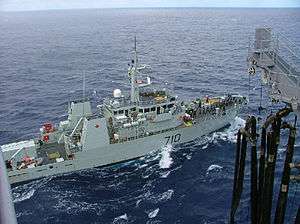
Organization
Naval Reserve Divisions (NRD)
Organized into 24 shore-based NRDs, Naval Reserve units are dedicated to training sailors to augment the Regular Force as well as functioning as local recruitment centres for the RCN and NAVRES. Manned by a small cadre of full-time reservists and Regular Force members to coordinate training and administration, operations at NRDs are conducted year-round with reservists frequently deploying on operations and training courses during the summer season.
| Ship | City | Province |
|---|---|---|
| HMCS Brunswicker | Saint John | New Brunswick |
| HMCS Cabot | St John's | Newfoundland and Labrador |
| HMCS Carleton | Ottawa | Ontario |
| HMCS Cataraqui | Kingston | Ontario |
| HMCS Champlain | Saguenay | Quebec |
| HMCS Chippawa | Winnipeg | Manitoba |
| HMCS d'Iberville | Rimouski | Quebec |
| HMCS Discovery | Vancouver | British Columbia |
| HMCS Donnacona | Montreal | Quebec |
| HMCS Griffon | Thunder Bay | Ontario |
| HMCS Hunter | Windsor | Ontario |
| HMCS Jolliet | Sept-Îles | Quebec |
| HMCS Malahat | Victoria | British Columbia |
| HMCS Montcalm | Quebec City | Quebec |
| HMCS Nonsuch | Edmonton | Alberta |
| HMCS Prevost | London | Ontario |
| HMCS Queen | Regina | Saskatchewan |
| HMCS Queen Charlotte | Charlottetown | Prince Edward Island |
| HMCS Radisson | Trois-Rivières | Quebec |
| HMCS Scotian | Halifax | Nova Scotia |
| HMCS Star | Hamilton | Ontario |
| HMCS Tecumseh | Calgary | Alberta |
| HMCS Unicorn | Saskatoon | Saskatchewan |
| HMCS York | Toronto | Ontario |
Naval Reserve Headquarters (NAVRESHQ)
Located in Quebec City at the Pointe-à-Carcy Naval Complex, Naval Reserve Headquarters (NAVRESHQ) oversees the operation of all 24 NRDs across Canada. Co-located with NAVRESHQ is NRD HMCS Montcalm, Naval Fleet School (Quebec) (NFS(Q)) and the Naval Museum of Quebec - Stanislas-Déry Naval Museum.
Naval Fleet School (Quebec) (NFS(Q))
Naval Fleet School (Quebec) (NFS(Q)) is the RCN's school dedicated to training reservists at various points of their careers and serving as the CAF centre of excellence for coastal and littoral warfare training .[9]
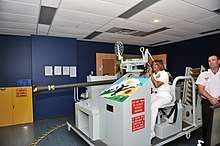
Naval Security Team (NST)
The Naval Security Team (NST) is a modular, scalable, flexible, and deployable naval team primarily composed of Naval Reservists, with Regular Force members rounding out the team when required.[10] Tasked with providing enhanced force protection (FP) and security of deployed RCN ships and personnel at home or overseas, the NST deployed for the first time in 2017 providing force protection for HMCS Winnipeg during her port visit to Busan, South Korea.[11][12] Headquartered at Canadian Forces Base (CFB) Esquimalt the NST reports directly to the Commander Canadian Fleet Pacific
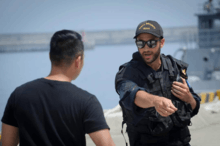
National Band of the Naval Reserve (NBNR)
Each summer, musicians from the five NRD's come together to form the National Band of the Naval Reserve (NBNR) (French: Musique Nationale de la Réserve Navale (MNRN)). During the summer months the NBNR is a full-time touring military band composed of musicians from HMCS Chippawa, HMCS Montcalm, HMCS Star, HMCS Tecumseh and HMCS York.
.jpg)
Personnel
Naval Reservists are individuals who are otherwise engaged in civilian careers while pursuing a military career in the CAF with NAVRES as an officer or non-commissioned member. They train and work for the Navy in the evenings, on weekends and during the summer period, in an occupation of their choice. They can be students, teachers, lawyers, delivery persons, secretaries, or other members of society. Most serve on a part-time basis, with no obligation to participate in any mission overseas. However, many full-time employment opportunities and deployments are available to those Reservists who volunteer for them.[13]
Throughout their career, sailors may serve in three classes of service:
- Class A (part-time);
- Class B (full-time non-operational); or
- Class C (full-time operational).
Training and pay
Reserve Force members are trained to the same level as their Regular Force counterparts. They usually begin training with their home unit to ensure that they meet the required basic professional military standards. They are paid 92.8% of Regular Force rates of pay, receive a reasonable benefits package and may qualify to contribute to a pension plan. In an effort to streamline the recruiting processes for naval reservists, in February 2017 NAVRES initiated the Expedited Reserve Enrolment to allow applicants who meet security, medical, and basic fitness standards to enroll in as few as 21 days or between two and three visits after initial contact with NRD recruiters.[14]
Naval Reserve occupations
The Canadian Armed Forces lists 28 occupations that are performed by either officer or non-commissioned members of the Naval Reserve.[15] Many occupations – such as intelligence officer - are common across all three environments, while others – such as naval communicator – are specifically Navy. As of December 2019, the following occupations are listed as Naval Reserve occupations:
- Communications research operator
- Cook
- Biomedical electronics technologist
- Boatswain
- Chaplain
- Financial services administrator
- Health care administration officer
- Human resources administrator
- Imagery technician
- Intelligence officer
- Intelligence operator
- Legal officer
- Logistics officer
- Medical officer
- Marine technician
- Medical technician
- Military police
- Military police officer
- Musician
- Naval combat information operator
- Naval communicator
- Naval warfare officer
- Nursing officer
- Personnel selection officer
- Pharmacy officer
- Physiotherapy officer
- Public affairs officer
- Supply technician
Ranks
Commissioned officers
| NATO code | OF-10 | OF-9 | OF-8 | OF-7 | OF-6 | OF-5 | OF-4 | OF-3 | OF-2 | OF-1 | OF(D) | Student officer | ||||||||||||||||||||||||
|---|---|---|---|---|---|---|---|---|---|---|---|---|---|---|---|---|---|---|---|---|---|---|---|---|---|---|---|---|---|---|---|---|---|---|---|---|
(Edit) |
No equivalent | 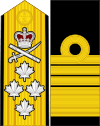 |
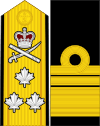 |
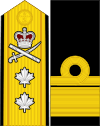 |
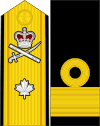 |
 |
 |
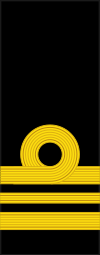 |
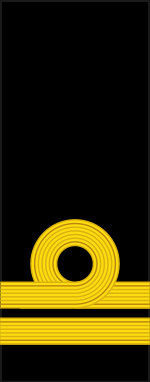 |
 |
 |
.svg.png) |
No equivalent | |||||||||||||||||||||||
| Admiral | Vice-admiral | Rear-admiral | Commodore | Captain(N) | Commander | Lieutenant-commander | Lieutenant(N) | Sub-lieutenant | Acting sub-lieutenant | Naval cadet | ||||||||||||||||||||||||||
| Amiral | Vice-amiral | Contre-amiral | Commodore | Capitaine de vaisseau | Capitaine de frégate | Capitaine de corvette | Lieutenant de vaisseau | Enseigne de vaisseau de 1re classe | Enseigne de vaisseau de 2e classe | Aspirant de marine | ||||||||||||||||||||||||||
Non-commissioned members
| Senior non-commissioned appointments of the RCN | |||
|---|---|---|---|
| Canadian Forces Chief Warrant Officer | Chief Petty Officer of the Navy/Command, Group, Chief Petty Officer | Command, Group, Formation, Fleet, Base Chief Petty Officer | |
 |
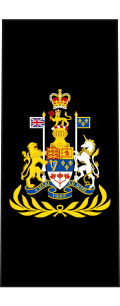 |
 |
|
| Non-commissioned member rank structure of the RCN | |||||||||
|---|---|---|---|---|---|---|---|---|---|
| Chief Petty Officer 1st class | Chief Petty Officer 2nd class | Petty Officer 1st class | Petty Officer 2nd class | Master Seaman | Leading Seaman | Able Seaman | Ordinary Seaman | Ordinary Seaman (Basic) | Ordinary Seaman (Recruit) |
| OR-9 | OR-8 | OR-7 | OR-6 | OR-5 | OR-4 | OR-3 | OR-2 | OR-1 | |
 |
 |
 |
 |
 |
 |
 |
 |
 |
 |
| CPO1 | CPO2 | PO1 | PO2 | MS | LS | AB | OS | OS (B) | OS (R) |
Senior commanders
Through the Commander of the Naval Reserve (Comd NAVRES), Commander Maritime Forces Pacific (MARPAC) is the functional authority responsible for the organization and management of the Naval Reserve.[16]
- Commander Naval Reserve
- Commodore Michael Hopper (2018-present)
- Commodore Marta B. Mulkins (2015–2018)
- Commodore David W. Craig, CD (2011-2015)
- Commodore Jennifer Bennett, CMM, CD (2007–2011)
- Commodore Bob Blakely (2004–2007)
- Commodore W.F. O'Connell (2000–2004)
- Commodore Raymond Zuliani (1997-2000)
- Commodore R. Beauniet (1995-1997)
- Commodore Jean-Claude Michaud (1993-1995)
- Senior Naval Reserve Adviser (SNRA)
- Commodore Jean-Claud Michaud (1992-1993)
- Commodore L.F. Orthlieb (1989-1992)
- Commodore G.L. Peer (1986-1989)
- Commodore Waldron Fox-Decent CM CMM OM CD (1983-1986)
- Commodore T.A.M. Smith (1977-1983)
- Commodore R.T. Bennett (1974-1977)
- Commodore D.R. Learoyd (1971-1974)
- Commodore B.S.C. Oland (1967-1971)
- Commanding Officer Naval Division (COND/Regular Force Officers)
- Commodore G.C. Edwards (1965-1966)
- Commodore P.D. Taylor (1960-1965)
- Commodore E.W. Finch-Noyes (1958-1960)
- Rear-Admiral K.F. Adams (1955-1958)
- Commodore K.F. Adams (1953-1955)
- Chief Staff Officer Reserves (CSOR)
- Captain (naval) P.W. Earl (1945)
- Captain (naval) P.B. Cross (1944-1945)
- Commanding Officer Reserve/naval Divisions (CORD/COND)
- Commodore, Second Class E.R. Brock (1942-1945)
- Naval Reserve Chief Petty Officer / Formation Chief Naval Reserve
- Chief Petty Officer 1st Class Michael Giguere (2017–Present)
- Chief Petty Officer 1st Class David Arsenault (2014–2017)
- Chief Petty Officer 1st Class Peter Caza (2012–2014)
- Chief Petty Officer 1st Class Leroy Hearns (2010–2012)
- Chief Petty Officer 1st Class Glynn Munroe (2007–2010)
- Chief Petty Officer 1st Class Glenn Woolfrey (2004–2007)
- Chief Petty Officer 1st Class John Redican (2001–2004)
See also
- List of Naval Reserve divisions
- Orca-class Patrol Craft Training (PCT) tender
- YAG-300 (Yard Auxiliary, General) vessels
- Rear Admiral Walter Hose, CBE
References
- Government of Canada, National Defence (2013-07-16). "NAVRES Vision / Mission | Naval Reserve | Royal Canadian Navy". www.navy-marine.forces.gc.ca. Retrieved 2019-11-11.
- Tucker, Gilbert Norman (1962). The Naval Service of Canada, Its Official History – Volume 1: Origins and Early Years. Ottawa: King's Printer.
- "Canadian Naval Reserve Early History". ns1763.ca. Retrieved 17 August 2017.
- Boutilier, James A. (2011-11-01). RCN in Retrospect, 1910-1968. UBC Press. ISBN 978-0-7748-4346-1.
- Gimblett, Richard Howard; Hadley, Michael L. (2010-11-16). Citizen Sailors: Chronicles of Canada's Naval Reserve, 1910-2010. Dundurn. ISBN 978-1-55488-867-2.
- Mulkins, Marta (2011). "A FINE BALANCE: CHALLENGES TO CANADA'S NAVAL RESERVE" (PDF). Canadian Forces College: 22.
- Navy, Government of Canada, National Defence, Royal Canadian. "NAVRES Headquarters & Schools | Naval Reserve | Royal Canadian Navy". www.navy-marine.forces.gc.ca. Retrieved 2017-03-29.
- Government of Canada, National Defence (n.d.). "navres-cffs". www.navy-marine.forces.gc.ca. Retrieved 2019-11-11.
- Government of Canada, National Defence (2013-09-18). "Naval Security Team | Specialized Units | Royal Canadian Navy". www.navy-marine.forces.gc.ca. Retrieved 2019-11-11.
- Leaf, The Maple. "Naval Security Team safeguards ships in foreign ports – The Maple Leaf". ml-fd.caf-fac.ca. Retrieved 2018-08-26.
- Navy, Government of Canada, National Defence, Royal Canadian. "The Naval Reserve Link: View Article | LINK - April 2017 | What is the Naval Security Team (NST)?". www.navy-marine.forces.gc.ca. Retrieved 2018-08-26.
- Navy, Government of Canada, National Defence, Royal Canadian. "Naval Reserve | Royal Canadian Navy". www.navy-marine.forces.gc.ca. Retrieved 2017-03-29.
- Defence, National. "Naval Reserve enrolls first candidate through Expedited Enrolment – Canada.ca". www.canada.ca. Retrieved 2017-03-29.
- "Careers | Canadian Armed Forces". forces.ca. Retrieved 2019-12-15.
- "Royal Canadian Navy Strategic Plan 2017-2022" (PDF). 2017. Retrieved 15 December 2019.
Further reading
- Gimblett, Richard H (2010), Citizen Sailors: Chronicles of Canada's Naval Reserve, 1910–2010, Dundurn Press, ISBN 9781554888672